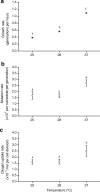Temperature responses of mutation rate and mutational spectrum in an Escherichia coli strain and the correlation with metabolic rate
- PMID: 30157765
- PMCID: PMC6116381
- DOI: 10.1186/s12862-018-1252-8
Temperature responses of mutation rate and mutational spectrum in an Escherichia coli strain and the correlation with metabolic rate
Abstract
Background: Temperature is a major determinant of spontaneous mutation, but the precise mode, and the underlying mechanisms, of the temperature influences remain less clear. Here we used a mutation accumulation approach combined with whole-genome sequencing to investigate the temperature dependence of spontaneous mutation in an Escherichia coli strain. Experiments were performed under aerobic conditions at 25, 28 and 37 °C, three temperatures that were non-stressful for the bacterium but caused significantly different bacterial growth rates.
Results: Mutation rate did not differ between 25 and 28 °C, but was higher at 37 °C. Detailed analyses of the molecular spectrum of mutations were performed; and a particularly interesting finding is that higher temperature led to a bias of mutation to coding, relative to noncoding, DNA. Furthermore, the temperature response of mutation rate was extremely similar to that of metabolic rate, consistent with an idea that metabolic rate predicts mutation rate.
Conclusions: Temperature affects mutation rate and the types of mutation supply, both being crucial for the opportunity of natural selection. Our results help understand how temperature drives evolutionary speed of organisms and thus the global patterns of biodiversity. This study also lend support to the metabolic theory of ecology for linking metabolic rate and molecular evolution rate.
Keywords: Evolutionary speed hypothesis; Molecular evolution; Mutation accumulation; Mutation rate; Mutational spectrum; Oxidative DNA damage.
Conflict of interest statement
Ethics approval and consent to participate
Not applicable.
Consent for publication
Not applicable.
Competing interests
The authors declare that they have no competing interests.
Publisher’s Note
Springer Nature remains neutral with regard to jurisdictional claims in published maps and institutional affiliations.
Figures



Similar articles
-
Anaerobically Grown Escherichia coli Has an Enhanced Mutation Rate and Distinct Mutational Spectra.PLoS Genet. 2017 Jan 19;13(1):e1006570. doi: 10.1371/journal.pgen.1006570. eCollection 2017 Jan. PLoS Genet. 2017. PMID: 28103245 Free PMC article.
-
Quantifying the Determinants of Evolutionary Dynamics Leading to Drug Resistance.PLoS Biol. 2015 Nov 18;13(11):e1002299. doi: 10.1371/journal.pbio.1002299. eCollection 2015. PLoS Biol. 2015. PMID: 26581035 Free PMC article.
-
The properties of spontaneous mutations in the opportunistic pathogen Pseudomonas aeruginosa.BMC Genomics. 2016 Jan 5;17:27. doi: 10.1186/s12864-015-2244-3. BMC Genomics. 2016. PMID: 26732503 Free PMC article.
-
Spontaneous mutation rates come into focus in Escherichia coli.DNA Repair (Amst). 2014 Dec;24:73-79. doi: 10.1016/j.dnarep.2014.09.009. Epub 2014 Oct 11. DNA Repair (Amst). 2014. PMID: 25308085 Review.
-
Irregularities in genetic variation and mutation rates with environmental stresses.Environ Microbiol. 2019 Nov;21(11):3979-3988. doi: 10.1111/1462-2920.14822. Epub 2019 Oct 15. Environ Microbiol. 2019. PMID: 31600848 Review.
Cited by
-
Isolation and characterization of porcine parvovirus in Vietnam.Vet World. 2024 Jul;17(7):1530-1537. doi: 10.14202/vetworld.2024.1530-1537. Epub 2024 Jul 13. Vet World. 2024. PMID: 39185042 Free PMC article.
-
Biodiversity-based development and evolution: the emerging research systems in model and non-model organisms.Sci China Life Sci. 2021 Aug;64(8):1236-1280. doi: 10.1007/s11427-020-1915-y. Epub 2021 Apr 22. Sci China Life Sci. 2021. PMID: 33893979 Review.
-
Deciphering the Foundations of Mitochondrial Mutational Spectra: Replication-Driven and Damage-Induced Signatures Across Chordate Classes.Mol Biol Evol. 2025 Feb 3;42(2):msae261. doi: 10.1093/molbev/msae261. Mol Biol Evol. 2025. PMID: 39903101 Free PMC article.
-
Effector Avr4 in Phytophthora infestans Escapes Host Immunity Mainly Through Early Termination.Front Microbiol. 2021 May 28;12:646062. doi: 10.3389/fmicb.2021.646062. eCollection 2021. Front Microbiol. 2021. PMID: 34122360 Free PMC article.
-
Abiotic selection of microbial genome size in the global ocean.Nat Commun. 2023 Mar 13;14(1):1384. doi: 10.1038/s41467-023-36988-x. Nat Commun. 2023. PMID: 36914646 Free PMC article.
References
-
- Cheng KC, Cahill DS, Kasai H, Nishimura S, Loeb LA. 8-hydroxyguanine, an abundant form of oxidative DNA damage, causes G->T and A->C substitutions. J Biol Chem. 1992;267:166–172. - PubMed
Publication types
MeSH terms
Grants and funding
LinkOut - more resources
Full Text Sources
Other Literature Sources

